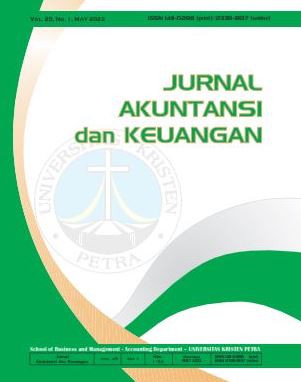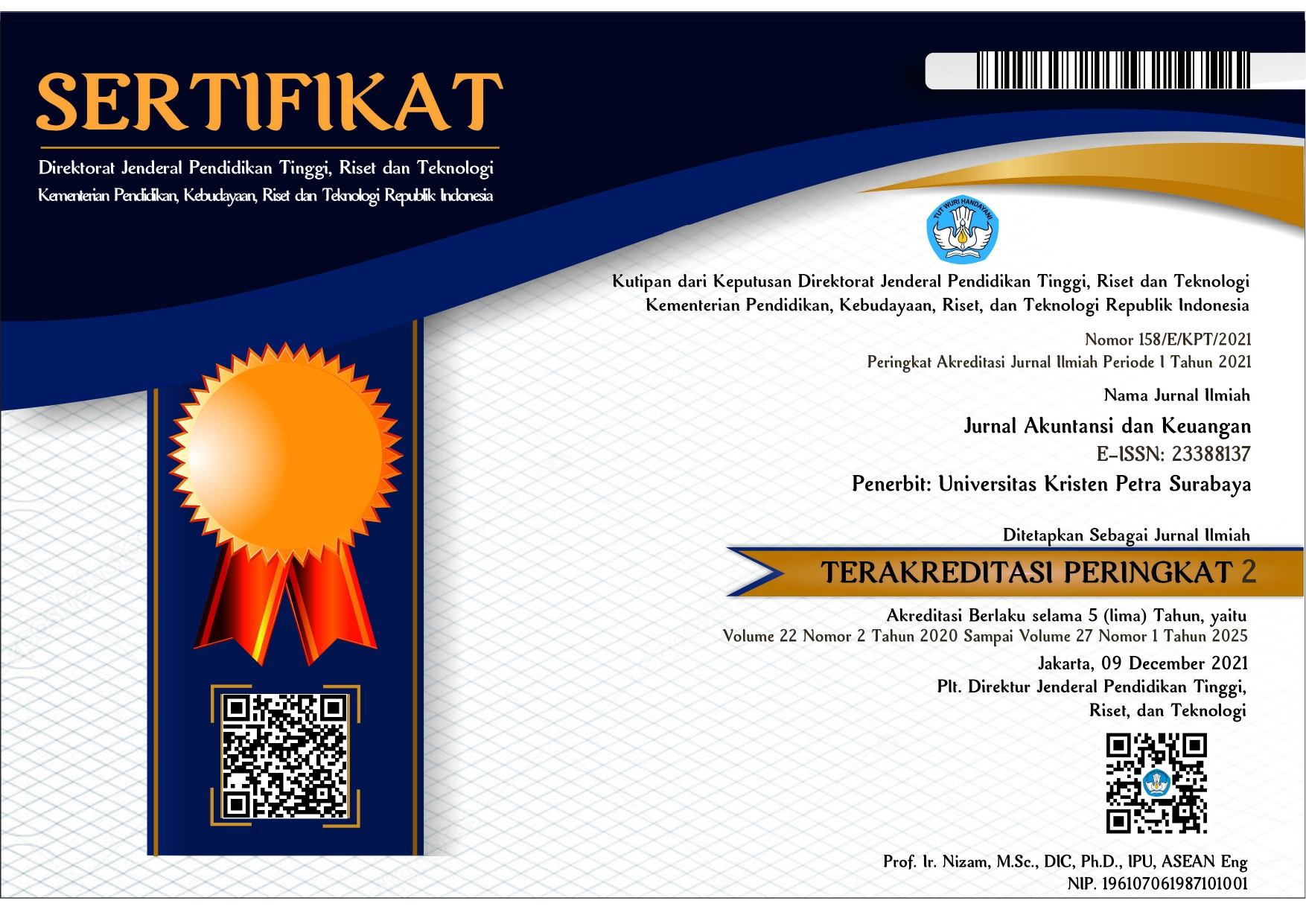Does Financial Literacy Matter in Cashless Payment Usage?
DOI:
https://doi.org/10.9744/jak.25.2.117-128Keywords:
Actual usage, behavioral intention, effort expectancy, financial literacy, social influenceAbstract
This study aims to examine the effect of social influence and effort expectancy on the intention to use and actual usage of cashless payment systems with financial literacy as moderating variable. To conduct this study questionnaires were distributed to all active accounting students at Airlangga University and from there, 128 research samples were obtained. The collected data were analyzed using WarpPLS 8.0. The results show that effort expectancy and social influence have a positive effect on the intention to use cashless payment systems. The result also shows that the intention to use cashless payment systems has a positive effect on the actual usage of cashless payment systems. In addition, the research results indicate that financial literacy does not moderate the effect of effort expectancy and social influence on the intention to use cashless payment. The results of this study are expected to provide insight and a better understanding of financial literacy and cashless payment system.
References
Al-Mamary, Y. H. S. (2022). Understanding the use of learning management systems by undergraduate university students using the UTAUT model: Credible evidence from Saudi Arabia. International Journal of Information Management Data Insights, 2(2). https://doi.org/10.1016/j.jjimei.2022.100092
Al-Saedi, K., Al-Emran, M., Ramayah, T., & Abusham, E. (2020). Developing a general extended UTAUT model for M-payment adoption. Technology in Society, 62(September 2019), 101293. https://doi.org/10.1016/j.tech-soc.2020.101293
Alam, M. M., Awawdeh, A. E., & Muhamad, A. I. Bin. (2021). Using e-wallet for business process development: challenges and prospects in Malaysia. Business Process Management Journal, 27(4), 1142–1162. https://doi.org/10.1108/BPMJ-11-2020-0528
Balakrishnan, V., & Shuib, N. L. M. (2021). Drivers and inhibitors for digital payment adoption using the Cashless Society Readiness-Adoption model in Malaysia. Technology in Society, 65(February), 101554. https://doi.org/10.1016/j.techsoc.2021.101554
Basuki, R., Tarigan, Z. J. H., Siagian, H., Limanta, L. S., Setiawan, D., & Mochtar, J. (2022). The effects of perceived ease of use, usefulness, enjoyment and intention to use online platforms on behavioral intention in online movie watching during the pandemic era. International Journal of Data and Net¬work Science, 6(1), 253–262. https://doi.org/10.5267/J.IJDNS.2021.9.003
Capgemini Research Institute. (2021). World Payments Report 2021. Retrieved from www.worldpaymentsreport.com
Chan, R., Troshani, I., Rao Hill, S., & Hoffmann, A. (2022). Towards an understanding of consumers’ FinTech adoption: the case of Open Banking. International Journal of Bank Marketing, 40(4), 886–917. https://doi.org/10.1108/IJBM-08-2021-0397
Chaurasia, S. S., Verma, S., & Singh, V. (2019). Exploring the intention to use M-payment in India: Role of extrinsic motivation, intrinsic motivation and perceived demonetization regulation. Transforming Government: People, Process and Policy, 13(3–4), 276–305. https://doi.org/10.1108/TG-09-2018-0060
Dang, V. T., Nguyen, N., Nguyen, H. V., Nguyen, H., Van Huy, L., Tran, V. T., & Nguyen, T. H. (2022). Consumer attitudes toward facial recognition payment: An examination of antecedents and outcomes. International Journal of Bank Marketing, 40(3), 511–535. https://doi.org/10.1108/IJBM-04-2021-0135
Djou, L. G., & Lukiastuti, F. (2021). The Moderating Influence of Financial Literacy on the Relationship of Financial Attitudes, Financial Self-Efficacy, and Credit Decision-Making Intensity. Jurnal Akuntansi Dan Keuangan, 23(2), 69–82. https://doi.org/10.9744/jak.23.2.69-82
Hair, J. F., Sarstedt, M., Hopkins, L., & Kup-pelwieser, V. G. (2014). Partial least squares structural equation modeling (PLS-SEM): An emerging tool in business research. European Business Review, 26(2), 106–121. https://doi.org/10.1108/EBR-10-2013-0128
Hall, J. A., & Liu, D. (2022). Social media use, social displacement, and wellbeing. Current Opinion in Psychology, 46, 101339. https://doi. org/10.1016/j.copsyc.2022.101339
Hasan, M., Le, T., & Hoque, A. (2021). How does financial literacy impact on inclusive finance? Financial Innovation, 7(1). https://doi.org/10.1186/s40854-021-00259-9
Jain, S., Khan, M. N., & Mishra, S. (2017). Understanding consumer behavior regarding luxury fashion goods in India based on the theory of planned behavior. Journal of Asia Business Studies, 11(1), 4–21. https://doi.org/10.1108/JABS-08-2015-0118
Kim, G. S., Park, S. B., & Oh, J. (2008). An examination of factors influencing consumer adoption of short message service (SMS). Psychology and Marketing, 25(8), 769–786.
Kuo, R. Z. (2020). Why do people switch mobile payment service platforms? An empirical study in Taiwan. Technology in Society, 62(June), 101312. https://doi.org/10.1016/j.techsoc.2020.101312
Kurniawan, B., Wahyuni, S. F., & Valentina, T. (2019). The influence of digital payments on public spending patterns. Journal of Physics: Conference Series, 1402(6). https://doi.org/10.1088/1742-6596/1402/6/066085
Lee, J. M., Lee, B., & Rha, J. Y. (2019). Determinants of mobile payment usage and the moderating effect of gender: Extending the UTAUT model with privacy risk. International Journal of Electronic Commerce Studies, 10(1), 43–64. https://doi.org/10.7903/ijecs.1644
Liébana-Cabanillas, F., Japutra, A., Molinillo, S., Singh, N., & Sinha, N. (2020). Assessment of mobile technology use in the emerging market: Analyzing intention to use m-payment services in India. Telecommunications Policy, 44(9). https://doi.org/10.1016/j.telpol.2020.102009
Lin, C., & Nguyen, C. (2011). Exploring e-payment adoption in Vietnam and Taiwan. Journal of Computer Information Systems, 51(4), 41–52. https://doi.org/10.1080/08874417.2011.11645500
Lusardi, A., & Mitchell, O. S. (2014). The Eco-nomic Importance of Financial Literacy: Theory and Evidence. Journal of Economic Literature, 52(1), 5–44. https://doi.org/10.1257/jel.52.1.5
Lusardi, A., & Mithell, O. S. (2011). Financial literacy around the world: an overview. Journal of Pension Economics and Finance, 10(4), 497–508. https://doi.org/10.1017/S1474747211000448
Marchewka, J., Liu, C., & Kostiwa, K. (2007). An Application of the UTAUT Model for Understanding Student Perceptions Using Course Management Software. Communications of the IIMA, 7(2), 93.
Mata, O. G. (2021). The effect of financial literacy and gender on retirement planning among young adults. International Journal of Bank Marketing. https://doi.org/10.1108/IJBM- 10-2020-0518
Matemba, E. D., & Li, G. (2018). Consumers’ willingness to adopt and use WeChat wallet: An empirical study in South Africa. Technology in Society, 53, 55–68. https://doi.org/10.1016/j.techsoc.2017.12.001
Mouna, A., & Jarboui, A. (2021). Understanding the link between government cashless policy, digital financial services and socio-demographic characteristics in the MENA countries. International Journal of Sociology and Social Policy. https://doi.org/10.1108/IJSSP-12-2020-0544
Musyaffi, A. M. (2022). Learning Management System The Existence of Self-Efficacy. 23(188), 224–230. https://doi.org/10.47750/QAS/23.188.30
Ng, D., Kauffman, R. J., Griffin, P., & Hedman, J. (2021). Can we classify cashless payment solution implementations at the country level? Electronic Commerce Research and Applications, 46(August 2020), 101018. https://doi.org/10.1016/j.elerap.2020.101018
Oliveira, T., Faria, M., Thomas, M. A., & Popovič, A. (2014). Extending the understanding of mobile banking adoption: When UTAUT meets TTF and ITM. International Journal of Information Management, 34(5), 689–703. https://doi.org/10.1016/j.ijinfomgt.2014.06.004
Pieters, J. J., Kokkinou, A., & van Kollenburg, T. (2022). Understanding Blockchain Technology Adoption by Non-experts: an Application of the Unified Theory of Acceptance and Use of Technology (UTAUT). Operations Research Forum, 3(1). https://doi.org/10.1007/s43069-021-00113-9
Potrich, A. C. G., Vieira, K. M., Coronel, D. A., & Bender Filho, R. (2015). Financial literacy in Southern Brazil: Modeling and invariance between genders. Journal of Behavioral and Experimental Finance, 6, 1–12. https://doi.org/10.1016/j.jbef.2015.03.002
Potrich, A. C. G., Vieira, K. M., & Mendes-Da-Silva, W. (2016). Development of a financial literacy model for university students. Management Research Review, 39(3), 356–376. https://doi.org/10.1108/MRR-06-2014-0143
Probowulan, D. (2022). The Sustainability of Pervasive Learning in Accounting Education: Strategy in the Transition of “Merdeka Belajar-Kampus Merdeka.” Jurnal Akuntansi Dan Keuangan, 24(1), 24–33. https://doi.org/10. 9744/jak.24.1.24-33
Qu, B., Wei, L., & Zhang, Y. (2022). Factors affecting consumer acceptance of electronic cash in China: an empirical study. Financial Innovation, 8(1). https://doi.org/10.1186/s408 54-021-00312-7
Rahadi, R. A., Nainggolan, Y. A., Afgani, K. F., Yusliza, M. Y., Faezah, J. N., Ramayah, T., Angelina, C. (2022). Towards a cashless society: Use of electronic payment devices among generation z. International Journal of Data and Network Science, 6(1), 137–146. https://doi.org/10.5267/J.IJDNS.2021.9.014
Rasyid, R., & Monica. (2019). Faktor-Faktor Yang Mempengaruhi Firm Financial Performance. Jurnal Multiparadigma Akuntansi, I(3), 675–682.
Sarstedt, M., Ringle, C. M., & Hair, J. F. (2017). Partial Least Squares Structural Equation Modeling. In Practical Assessment, Research and Evaluation (Vol. 21).
Sivathanu, B. (2019). Adoption of digital payment systems in the era of demonetization in India: An empirical study. Journal of Science and Technology Policy Management, 10(1), 143–171. https://doi.org/10.1108/JSTPM-07-2017-0033
Suki, N. M., & Suki, N. M. (2017). Determining students’ behavioural intention to use animation and storytelling applying the UTAUT model: The moderating roles of gender and experience level. International Journal of Management Education, 15(3), 528–538. https://doi.org/10.1016/j.ijme.2017.10.002
Świecka, B., Terefenko, P., & Paprotny, D. (2021). Transaction factors’ influence on the choice of payment by Polish consumers. Journal of Retailing and Consumer Services, 58(June 2020), 102264. https://doi.org/10.1016/ j.jretconser.2020.102264
Tang, Y. M., Chau, K. Y., Hong, L., Ip, Y. K., & Yan, W. (2021). Financial innovation in digital payment with wechat towards electronic business success. Journal of Theoretical and Applied Electronic Commerce Research, 16(5), 1844–1861. https://doi.org/10.3390/jtaer16050103
Te’eni-Harari, T. (2016). Financial literacy among children: the role of involvement in saving money. Young Consumers, 17(2), 197–208. https://doi.org/10.1108/YC-01-2016-00579
van Bussel, M. J. P., Odekerken–Schröder, G. J., Ou, C., Swart, R. R., & Jacobs, M. J. G. (2022). Analyzing the determinants to accept a virtual assistant and use cases among cancer patients: a mixed methods study. BMC Health Services Research, 22(1), 1–23. https://doi.org/10.1186/s12913-022-08189-7
van Rooij, M., Lusardi, A., & Alessie, R. (2011). Financial literacy and stock market participation. Journal of Financial Economics, 101(2), 449–472. https://doi.org/10.1016/j.jfineco.2011.03.006
Venkatesh, V., Morris, M. G., Davis, G. B., & Davis, F. D. (2003). User Acceptance of Information Technology: Toward a Unified View. MIS Quaterly, 27(3), 425–478.
Verma, S., Chaurasia, S. S., & Bhattacharyya, S. S. (2020). The effect of government regulations on continuance intention of in-store proximity mobile payment services. International Journal of Bank Marketing, 38(1), 34–62. https://doi.org/10.1108/IJBM-10-2018-0279
Widayat, W., Masudin, I., & Satiti, N. R. (2020). E-Money Payment: Customers’ Adopting Factors and the Implication for Open Innovation. Journal of Open Innovation: Technology, Market, and Complexity, 6(3), 57. https://doi.org/10.3390/joitmc6030057
Xue, R., Gepp, A., O’Neill, T. J., Stern, S., & Vanstone, B. J. (2021). Financial literacy and financial strategies: The mediating role of financial concerns. Australian Journal of Management, 46(3), 437–465. https://doi.org/10.1177/0312896220940762
Yakean, S. (2020). Advantages and Disadvantages of a Cashless System in Thailand during the COVID-19 Pandemic. The Journal of Asian Finance, Economics and Business, 7(12), 385–388. https://doi.org/10.13106/jafeb.2020. vol7.no12.385
Yuen, K. F., Chua, J., Li, K. X., & Wang, X. (2022). Consumer’s adoption of virtual reality technologies for marine conservation: Motivational and technology acceptance perspectives. Technological Forecasting and Social Change, 182(April), 121891. https://doi.org/10.1016/j.tech-fore.2022.121891
Downloads
Published
How to Cite
Issue
Section
License
Authors who publish with this journal agree to the following terms:
- Authors retain the copyright and publishing right, and grant the journal right of first publication with the work simultaneously licensed under a Creative Commons Attribution License that allows others to share the work with an acknowledgement of the work's authorship and initial publication in this journal.
- Authors are able to enter into separate, additional contractual arrangements for the non-exclusive distribution of the journal's published version of the work (e.g., post it to an institutional repository or publish it in a book), with an acknowledgement of its initial publication in this journal.
- Authors are permitted and encouraged to post their work online (e.g., in institutional repositories or on their website) followingthe publication of the article, as it can lead to productive exchanges, as well as earlier and greater citation of published work (See The Effect of Open Access).<a href="http://creativecommons.org/lice















